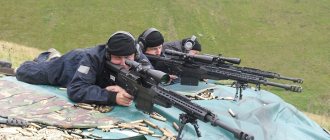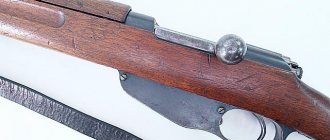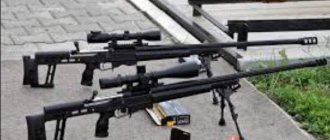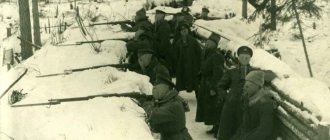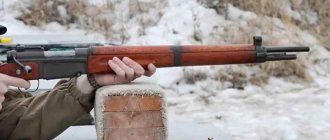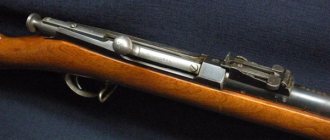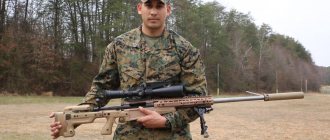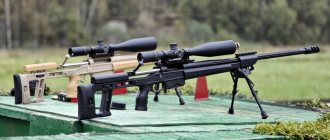| M1 Garand | |
| M1 Garand | |
| Type | self-loading rifle |
| A country | USA |
| Service history | |
| Years of use | 1936-1957 |
| Adopted | 1936 |
| Wars and conflicts | World War II, Korean War, Vietnam War |
| Production history | |
| Constructor | Garand, John |
| Designed by | 1931 |
| Manufacturer | production and assembly : Springfield Arsenal, Winchester, Harrington & Richardson, International Harvester, Beretta, Breda, FMAP mainsprings : ALCO[1] |
| Total issued | about 5.4 million |
| Options | see options |
| Characteristics | |
| Weight, kg | 4,32 |
| Length, mm | 1105 |
| Barrel length, mm | 610 |
| Cartridge | .30-06 Springfield (7.62×63 mm) .276 Pedersen (English) 7.62×51 mm NATO post-war use by the US Navy |
| Caliber, mm | 7,62 |
| Work principles | removal of powder gases, rotary bolt |
| Initial bullet speed, m/s | 865 |
| Sighting range, m | 550 |
| Maximum range, m | 1800 |
| Type of ammunition | 8-round pack (.30-06 Springfield), 10-round pack (.276 Pedersen) |
| Aim | diopter rear sight, ball front sight |
| Media files on Wikimedia Commons | |
This term has other meanings, see.
M1 Garand
(Garand)
, officially
US Rifle, Caliber .30, M1
, is an American self-loading rifle from the Second World War.
The M1 Garand rifle became the 4th self-loading rifle in the world adopted for service (the first was the Mexican Mondragon rifle, the second was the French RSC 1917 [en], and the third was the Soviet ABC-36, adopted for service a few months earlier and released in quantity more than 60,000 units), and the first to be adopted as the main infantry weapon. Reliable and accurate, it served US troops in World War II and the Korean War. General Patton once called this rifle “the greatest weapon of war ever created”
[2]. Garand is still popular on the civilian weapons market.
Story
The rifle was designed by John Garand in 1929. The first prototype was the T3 rifle with the removal of powder gases, which already had a return spring in the gas piston tube and locking the barrel bore by turning the bolt. The rifle is in the process of fine-tuning and thorough testing in 1931-1933. consistently received indices T3E2, T1E1. An improved modification of the T3, T1E2 received the designation M1, and in 1936, as a result of various developments and tests, the rifle designed by John Garand was adopted for service under the designation “US rifle, .30 caliber, M1.” With some delay (in 1937), the first batch of rifles arrived at military units. When the M1 began to enter service with the American army, soldiers began to complain about its unreliability. Delays in shooting began approximately after the 6th shot. This led to consideration of this problem in Congress, which appointed a special commission to identify shortcomings. The commission came to the conclusion that it was necessary to modernize the gas exhaust system of the weapon, since this was what caused the problems when shooting. The modernized rifle appeared in the same year and successfully passed tests, and in 1941 its production began (rifles of earlier releases were remade to the new standard).
However, re-equipment of the army was slow, and the bulk of American infantry fought in the early battles of World War II with the Springfield M1903 in their hands. Most US Marine units were rearmed with the M1 Garand only towards the end of 1943.[3]
History[edit | edit code]
The rifle was designed by John Garand in 1929. The first prototype was the T3 rifle with the removal of powder gases, which already had a return spring in the gas piston tube and locking the barrel bore by turning the bolt. The rifle is in the process of fine-tuning and thorough testing in 1931-1933. consistently received indices T3E2, T1E1. An improved modification of the T3, T1E2 received the designation M1, and in 1936, as a result of various developments and tests, the rifle designed by John Garand was adopted for service under the designation “US rifle, .30 caliber, M1.” With some delay (in 1937), the first batch of rifles arrived at military units. When the M1 began to enter service with the American army, soldiers began to complain about its unreliability. Delays in shooting began approximately after the 6th shot. This led to consideration of this problem in Congress, which appointed a special commission to identify shortcomings. The commission came to the conclusion that it was necessary to modernize the gas exhaust system of the weapon, since this was what caused the problems when shooting. The modernized rifle appeared in the same year and successfully passed tests, and in 1941 its production began (rifles of earlier releases were remade to the new standard).
However, re-equipment of the army was slow, and the bulk of American infantry fought in the early battles of World War II with the Springfield M1903 in their hands. Most US Marine units were rearmed with the M1 Garand only towards the end of 1943.[3]
In connection with the transition of the United States in 1952 to the use of a new rifle-machine-gun cartridge, a method was developed to convert previously released M1 Garand rifles to a new cartridge (patented in March 1966)[4].
Device
Cartridge pack for 8 rounds .30-06
Firing a Rifle Grenade
The M1 Garand rifle is a self-loading weapon with a 7.62mm fixed barrel with four right-hand rifling. The rifle mechanism works on the principle of removing powder gases through a transverse hole in the barrel wall. The gas piston is fixedly attached to the bolt frame. Locking the bolt by turning occurs when the bolt is rotated around the longitudinal axis and the two lugs of the bolt enter the grooves of the receiver.
The trigger mechanism is a trigger mechanism, a fairly simple device, which was later often copied in a more or less modified form; when disassembling the weapon, it was completely separated from the receiver. The rifle had a very successful and subsequently often copied safety in the form of a lever-flag in the front part of the trigger guard; to put it on safety, it was moved back, inside the trigger guard, so that the shooter could always easily determine by touch whether the rifle was on safety. If necessary (for example, in case of a misfire), the hammer could be cocked without “jerking” the bolt by pulling the rear part of the trigger guard down and forward using a special ring - another evidence of how much attention the creators of the rifle paid to the issues of ease of handling the weapon.
Ammunition was supplied in packs of 8 .30-06 cartridges (7.62×63 mm, standard American ammunition of the first half of the 20th century), which were inserted from above through an open bolt. The difference between a pack and a clip is that it is in the store constantly, until the cartridges are completely used up, and after that it is automatically ejected through an open window at the top of the receiver when the bolt is open. To speed up reloading, after the last shot fired, the bolt frame remained in the rear position due to the action of the bolt stop, while the empty cartridge pack was automatically thrown up, making room for the next pack of cartridges. Therefore, reloading the M1 rifle was done extremely quickly; to do this, it was enough to insert a pack into the receiver window and release the bolt from the delay. This interesting system, which increased the practical rate of fire, had a certain drawback: the ejection of an empty pack was accompanied by a sharp sound, which could warn the enemy that the rifle’s ammunition was exhausted. Often, Japanese soldiers in the Pacific theater of operations, hearing such a sound, managed to run out of cover and destroy the American shooter before he had time to reload his rifle. In addition, the use of packs precluded reloading the rifle. There were other disadvantages of such a system - if there were cartridges and no packs, the rifle turned into a single-shot rifle, and there were also increased requirements for packs of cartridges. There were cases when a full pack, due to geometric inaccuracies, flew out as empty after the first shot. Although later they began to use one drawback to their advantage - the soldiers hit the rifle (a sharp sound was heard) and threw an empty pack of cartridges into the air, thus misleading the enemy about the availability of ammunition. The question of how serious a disadvantage “M1 ringing” was in practice remains debatable. US Army soldier Charles Petrie had the opportunity to discuss it with a group of German veterans who participated in the Battle of Bastogne. All Germans considered this topic ridiculous. In the midst of the battle, the sound was still not audible, and besides, everyone was well aware of the tricks associated with it[4].
Some rifles were equipped with the 1943 M7 rifle grenade launcher.
Device[edit | edit code]
Cartridge pack for 8 rounds of .30-06
The M1 Garand rifle is a self-loading weapon with a 7.62 mm fixed barrel with four right-hand rifling. The rifle mechanism works on the principle of removing powder gases through a transverse hole in the barrel wall. The gas piston is fixedly attached to the bolt frame. Locking the bolt by turning occurs when the bolt is rotated around the longitudinal axis and the two lugs of the bolt enter the grooves of the receiver.
The trigger mechanism is a trigger mechanism, a fairly simple device, which was later often copied in a more or less modified form; when disassembling the weapon, it was completely separated from the receiver. The rifle had a very successful and subsequently often copied safety in the form of a lever-flag in the front part of the trigger guard; to put it on safety, it was moved back, inside the trigger guard, so that the shooter could always easily determine by touch whether the rifle was on safety. If necessary (for example, in case of a misfire), the hammer could be cocked without “jerking” the bolt by pulling the rear part of the trigger guard down and forward using a special ring - another evidence of how much attention the creators of the rifle paid to the issues of ease of handling the weapon.
Ammunition was supplied in packs of 8 .30-06 cartridges (7.62×63 mm, standard American ammunition of the first half of the 20th century), which were inserted from above through an open bolt. The pack is constantly in the store until the cartridges are completely used up, and after that it is automatically ejected through an open window at the top of the receiver when the bolt is open. To speed up reloading, after the last shot fired, the bolt frame remained in the rear position due to the action of the bolt stop, while the empty cartridge pack was automatically thrown up, making room for the next pack of cartridges. Thanks to this, reloading the rifle was carried out extremely quickly; to do this, it was enough to insert a new pack into the receiver window and release the bolt from the delay (In addition, the shooter was required to hold the mechanism with the side of his hand and not allow it to close, otherwise his strength would be enough, to break a finger) This interesting system, which increased the practical rate of fire, had a certain drawback: the ejection of an empty pack was accompanied by a characteristic ringing sound, by which the enemy could determine that the rifle’s ammunition had been used up. Often, Japanese soldiers in the Pacific theater of operations, hearing such a sound, managed to run out of cover and destroy the American shooter before he had time to reload his rifle. In addition, the use of packs precluded reloading the rifle. There were other disadvantages of such a system - if there were cartridges and no packs, the rifle turned into a single-shot rifle, and there were also increased requirements for packs of cartridges. There were cases when a full pack, due to geometric inaccuracies, flew out as empty after the first shot. Although later they began to use one drawback to their advantage - the soldiers hit the rifle (a sharp sound was heard) and threw an empty pack of cartridges into the air, thus misleading the enemy about the availability of ammunition. The question of how serious a disadvantage “M1 ringing” was in practice remains debatable. US Army soldier Charles Petrie had the opportunity to discuss it with a group of German veterans who participated in the Battle of Bastogne. All Germans considered this topic ridiculous. In the midst of the battle, the sound was still not audible, and besides, everyone was well aware of the tricks associated with it[5].
Another feature of loading the rifle was that if the pack was fed incorrectly by hand, the automatic shutter acted in such a way that it pinched the shooter’s thumb (this phenomenon became known as the “M1/Garand thumb”, from English - “M1/Garand thumb” )[6].
Some rifles were equipped with the 1943 M7 rifle grenade launcher.
Options
Garand M1С
Garand M1D
Rifle was produced in several versions:
- M1
- standard infantry rifle mod.
1936 (designated T1E2
) - M1C
- sniper rifle mod.
1944 with an M81 optical sight, before being put into service it was designated M1E7
. In 1951, it was officially adopted by the US Marine Corps. - M1D
- a sniper rifle with an M82 optical sight and a flash suppressor, before being adopted into service it was designated
M1E8
. In June 1944 it was adopted by the US Army. - The Beretta BM 59 is a semi-automatic rifle created in Italy based on the M1 Garand design.
- M1 Conversion Rifle
is a modification chambered for the 7.62x51 mm NATO cartridge, developed by the Philippines, equipped with a detachable 20-round magazine from the American M14 rifle[5]. - M26 Tanker Garand
- a shortened modification for tank crews.
Characteristics of the airsoft rifle G&G M1 Garand Real Wood
| Manufacturer | G&G |
| Combat prototype | M1 Garand self-loading rifle (USA, 1936) |
| View | Airsoft rifle |
| Type | AEG (electric drive) |
| Caliber | 6.0 mm |
| Speed | 125-135 m/s |
| Type of ammunition | Plastic balls 6 mm |
| Barrel type | Smooth |
| Number of charges | 20 pcs |
| Shooting mode | Semi-automatic |
| Energy source | Battery 11.1 V, Mini connector |
| Blowback | No |
| Fuse | Eat |
| Sighting rail Weaver (Picatinny) / Dovetail 11 mm | No |
| Housing material | Metal |
| Stock material | Tree |
| Color | Black, wood |
| Size | Length - 1103 mm, barrel - 510 mm |
| Weight | 3650 grams |
| Country of Origin | Taiwan |
| Equipment | Rifle, magazine, packaging, brief documentation, copy of certificate (upon buyer's request), loader, cleaning rod |
Airsoft rifle G&G M1 Garand Real Wood buy in the Popadiv10 online store. Airsoft rifle G&G M1 Garand Real Wood at a low price of RUB 28,624. You can pay for your order by mail upon receipt in any part of the Russian Federation. Before placing an order, be sure to check the price and contents of the product by phone (during business hours) or by e-mail and feedback system (at any time convenient for you).
In service
Honor guard of the Greek Presidential Guard with M1 Garand rifles
- USA USA - removed from service with the US Army in 1957, but continued to be used until 1963, later remained in service with the Navy and until 1966 in service with the National Guard[6], used as a ceremonial weapon in honor guard companies and military educational institutions.
- Germany Germany - after the creation of the Bundeswehr, M1C sniper rifles received under the military assistance program from the United States entered service under the name G52, and M1D rifles under the name G53.
- Great Britain Great Britain - during the Second World War, 38,001 were delivered from the USA under Lend-Lease[7]
- Haiti Haiti - received from the USA, remained in service until the disbandment of the Haitian armed forces in September 1994[8].
- Greece Greece - supplied under the military assistance program from the United States [9], removed from service, but used as a ceremonial weapon in honor guard companies.
- Cuba Cuba - supplied by the USA to the Cuban army of F. Batista, after the victory of the Cuban revolution, a certain amount was captured from the "gusanos".
- Nicaragua Nicaragua - were in service with the National Guard until July 1979[10], after the victory of the Sandinista revolution they were in service with the territorial units of the people's militia[11].
- Panama Panama - were in service with the armed forces of Panama until December 1989, when, during the US invasion of Panama, all Panamanian armed forces were disarmed and disbanded[12]
- El Salvador El Salvador - a total of 1,576 rifles were received from the United States under the military assistance program: in 1945-1965. 1,365 M1 rifles were supplied to the Salvadoran army, and 211 sniper rifles were also received[13] (of which, 189 M1D sniper rifles were received under the military assistance program from the United States in the 1980s)[14].
- Turkey Turkey
- France France - during the Second World War, 58,114 were supplied to the forces of “Fighting France” under Lend-Lease from the United States [15]
- South Vietnam South Vietnam - supplied from the United States under the military assistance program, were in service with the South Vietnamese army until 1975.
- Japan Japan - after the end of World War II, M1s were supplied to the Japanese police and the “Japanese Self-Defense Forces” under the military assistance program from the United States, and remained in service as of the early 1980s[16].
Notes
- News Quiz! (English) // LIFE
: Magazine. - NY: Time Inc., December 15, 1941. - Vol.11 - No.24 - P.97. - Original phrase: In my opinion, the M1 Rifle is the greatest battle implement ever devised.
- Popenker M.R., Milchev M.N. World War II: The Gunsmiths' War. M.: Yauza, Eksmo, 2008. p. 527
- More On The "Ping" (American Rifleman magazine, 2012)
- M1 Garand Conversion
- Leroy Thompson. The M14 Battle Rifle. Osprey Publishing, Ltd. 2014. page 34
- 22 line Page 17 (5). Section 3A, pages 1-26 Ordnance - General Supplies. Lend-Lease Act (Supplies from the USA under Lend-Lease during the Second World War)
- Mission to Haiti: the coutryside; singing and dancing, Haitians defy Military // The New York Times, September 30, 1994
- Lieutenant Colonel A. Ryzhkov. Units and units of the Greek army // Military Bulletin, No. 10, 1963. pp. 118-123
- As an example, M-1 Garand rifles were captured by the Sandinistas on July 5, 1979, after storming the barracks in Jinotepe, where they were in service with one of the provincial units of the National Guard of Nicaragua: the path of struggle and victory / comp. V. G. Tkachenko, ed. K. N. Kurin. M., Politizdat, 1985. p.209
- The people are on guard of the revolution // Izvestia, No. 200 (20546) dated July 19, 1983. p.5
- Gordon Rottman, Ron Volstad. Panama, 1989-1990. London, Osprey Publishing Ltd., 1991. page 14
- Julio A. Montes. Infantry Weapons of the Salvadoran Forces // Small Arms Review, May 2000
- US Foreign Military Sales / Deliveries of Light Weapons to El Salvador (1980—1993). Source: Federation of American Scientists, Arms Sales Monitoring Project // William Godnick (USA), Erick Haven (USA), Ivonne Martinez-Henriquez (El Salvador). SAND Brief: El Salvador (March 2000). Periodic Brief prepared for the Small Arms Survey
- 22 line Page 17 (5). Section 3A, pages 1-26 Ordnance - General Supplies. Lend-Lease Act (Supplies from the USA under Lend-Lease during the Second World War)
- Colonel-Reserve Engineer I. Yesayan, Lieutenant Colonel-Reserve Engineer E. Slutsky. Melee weapons of the Japanese army // “Equipment and weapons”, No. 1, 1981. pp. 36-37
Notes[edit | edit code]
- News Quiz! (English) // LIFE
: Magazine. - NY: Time Inc., December 15, 1941. - Vol.11 - No.24 - P.97. - Original phrase: In my opinion, the M1 Rifle is the greatest battle implement ever devised.
- Popenker M.R., Milchev M.N. World War II: The Gunsmiths' War. M.: Yauza, Eksmo, 2008. p. 527
- Jacob Byer. Conversion of Ml type firearms to M14 ammunition. US Patent US3362095A (March 7, 1966)
- More On The "Ping" (American Rifleman magazine, 2012)
- M1 Garand and your Thumb (undefined)
. Retrieved April 20, 2020. - M1 Garand Conversion
- Leroy Thompson. The M14 Battle Rifle. Osprey Publishing, Ltd. 2014. page 34
- ↑ 1 2
22 line Page.
17 (5). Section 3A, pages 1-26 Ordnance - General Supplies. Lend-Lease Act (Supplies from the USA under Lend-Lease during the Second World War) (unspecified)
(inaccessible link). Retrieved July 28, 2020. Archived January 27, 2011. - Mission to Haiti: the coutryside; singing and dancing, Haitians defy Military // The New York Times, September 30, 1994
- Lieutenant Colonel A. Ryzhkov. Units and units of the Greek army // Military Bulletin, No. 10, 1963. pp. 118-123
- As an example, M-1 Garand rifles were captured by the Sandinistas on July 5, 1979, after storming the barracks in Jinotepe, where they were in service with one of the provincial units of the National Guard of Nicaragua: the path of struggle and victory / comp. V. G. Tkachenko, ed. K. N. Kurin. M., Politizdat, 1985. p.209
- The people are on guard of the revolution // Izvestia, No. 200 (20546) dated July 19, 1983. p.5
- Gordon Rottman, Ron Volstad. Panama, 1989-1990. London, Osprey Publishing Ltd., 1991. page 14
- Julio A. Montes. Infantry Weapons of the Salvadoran Forces // Small Arms Review, May 2000
- US Foreign Military Sales / Deliveries of Light Weapons to El Salvador (1980—1993). Source: Federation of American Scientists, Arms Sales Monitoring Project // William Godnick (USA), Erick Haven (USA), Ivonne Martinez-Henriquez (El Salvador). SAND Brief: El Salvador (March 2000). Periodic Brief prepared for the Small Arms Survey
- Colonel-Reserve Engineer I. Yesayan, Lieutenant Colonel-Reserve Engineer E. Slutsky. Melee weapons of the Japanese army // “Equipment and weapons”, No. 1, 1981. pp. 36-37

